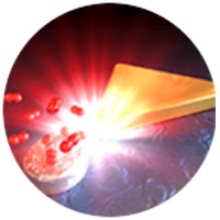Metal nanostructures offer a large variety of fascinating optical properties. Among others, such plasmonic nanostructures concentrate visible and infrared radiation in volumes of only a few cubic nanometers resulting in huge electromagnetic fields. These strongly enhanced near-fields are of extraordinary interest for ultra-sensitive sensing techniques with applications in analytical science, medicine, explosive detection etc. In our labs, we develop such plasmonic sensing technologies for the real-time detection of gases and the label-free recognition of biomolecules in extremely low concentrations.
Plasmonic Gas Sensing
The sensitive and reliable detection of explosive or hazardous gases such as hydrogen and nitrogen oxide is a key requirement for the safe operation of large-scale chemical processing plants. In order to develop robust, all-optical sensing devices, we utilize complex hybrid plasmonic nanostructures which combine gas specific materials with "classic" plasmonic materials such as gold. By placing a palladium nanodisk next to a highly resonant gold bowtie nanoantenna, we can use the large electromagnetic near-fields to detect small hydrogen-induced dielectric changes in the palladium. These deeply subwavelength dielectric changes can then be observed as resonance shifts in the optical spectrum of the nanoantenna. By employing different structure geometries and reagent-specific material systems, we extend this approach towards the detection of a wide range of industrially and scientifically relevant gases and chemical reactions, possibly down to the single molecule level.
Antenna-enhanced Infrared Spectroscopy
The label-free and specific detection of biomolecules requires a specific recognition of analytes, which can be provided by infrared spectroscopy. Unfortunately, infrared spectroscopy suffers from relatively low absorption cross-sections of molecular vibrations and thus sensing applications are hampered. To overcome this limitation we develop tailored nanostructures resonant with the infrared vibrations of the analytes. The huge near-fields of such resonantly excited nanostructures enhance the infrared vibrational signals by up to five orders of magnitude. This allows an ultra-sensitive and label-free detection of analytes and paves the way towards in-situ analysis of biomedical processes in low concentrations.
Further Information
- Nanoantenna-enhanced gas sensing in a single tailored nanofocus
N. Liu, M. Tang, M. Hentschel, H. Giessen and A. Alivisatos
Nat. Mater. 10, 631 (2011). - Vibrational near-field mapping of planar and buried 3D plasmonic nanostructures
D. Dregely, F. Neubrech, H. Duan and H. Giessen
Nat. Commun. 4, 2237 (2013). - From Dark to Bright: First-Order Perturbation Theory with Analytical Mode Normalization for Plasmonic Nanoantenna Arrays Applied to Refractive Index Sensing
T. Weiss, M. Mesch, M. Schäferling, H. Giessen, W. Langbein and E. Muljarov
Phys. Rev. Lett. 116, 237401 (2016).




